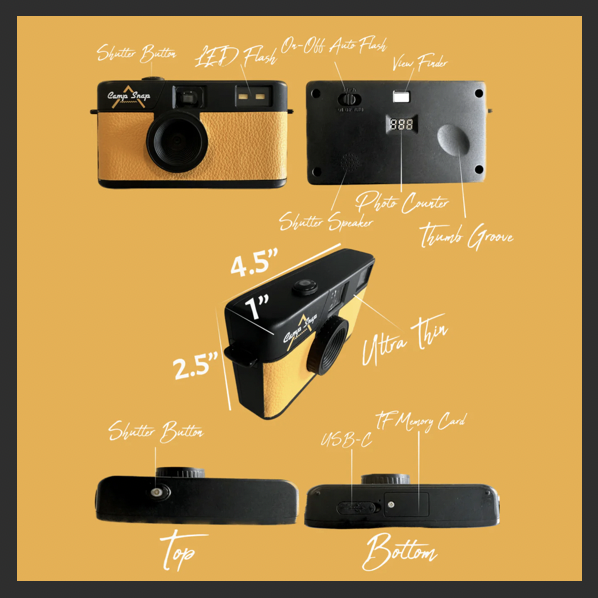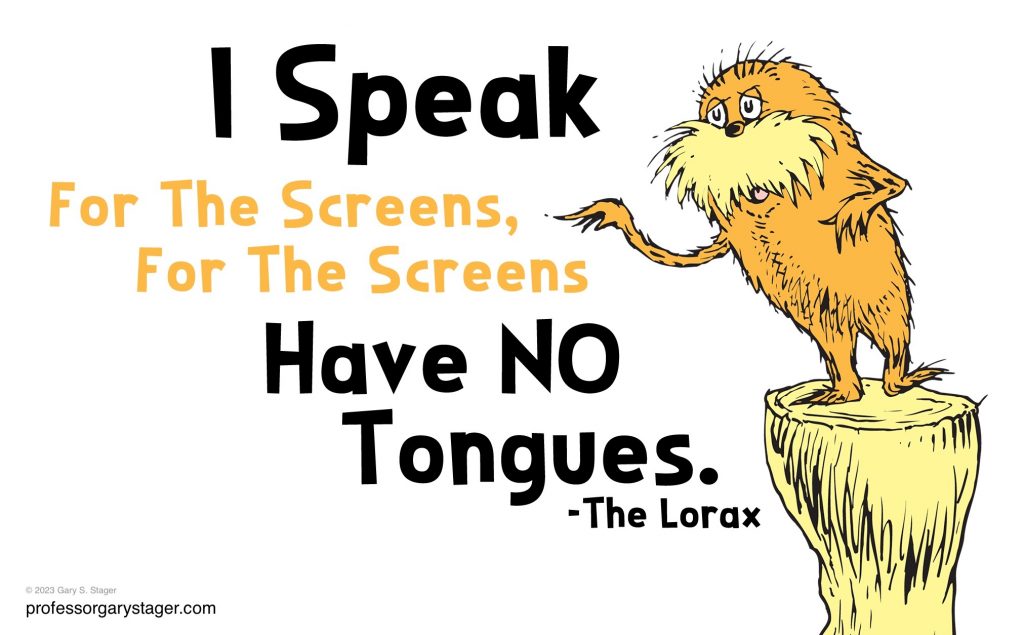An ad for a forthcoming product crossed my MyFace stream today and I am grateful for the number of competing issues it caused me to ponder. Let me stipulate that I am not 100% positive I hate the product, because a tiny part of me admires the ingenious, albeit cynical, entrepreneurship and another part wonders if there might actually be a fun creative “off-label” use for the thing.
The (vaporware) product in question is the Camp Snap, a small, simple, fixed-lens, durable, $40 digital camera designed for kids attending summer camp. You might be asking yourself, “Don’t digital cameras already exist?” or “Can’t they just use their phone?”
Au contraire, the secret sauce of Camp Snap is that it is a digital camera without a screen, because don’t you remember? SCREENS ARE BAD!
Apparently, camps, like schools, are banning cellphones.
Let’s not find a constructive way to engage with the world. Don’t develop impulse control. Avoid any chance of amplifying human potential. Refrain from creating experiences more compelling than scrolling. Just confiscate the phones. Everything in life was better in 1978!
I grow concerned when the default position of adults is to be gratuitously mean to children – in order to maintain dominance or based on a misplaced sense of nostalgia.
Please note that I am a giant fan of summer camp. In fact, most of the problems associated with childhood, education, parenting, and society at-large would be solved if every child had access to high quality summer camp. I even run Constructing Modern Knowledge, a summer camp for educators. I attended summer camp. I started my career at summer camp. Anyone wishing to be employed as a teacher should have worked at a summer camp. I love summer camp.
But I think I hate the Camp Snap…
- Aside from the fact that it is wrong to be mean to children, kids are notoriously terrible photographers. Photography is a skill/art developed (get it?) over time. The screen on a digital camera enhances photography and allows less experienced photographers to produce better photographs. Better photographs produce richer memories of summer camp.
- One feature of the Camp Snap is that its memory card is impossible remove without the use of a screwdriver. The argument for this design is that kids will not lose the card and parents can safely remove it when a kid returns home from camp. That’s swell as long as the kid who can’t be trusted with a screen, doesn’t lose the camera over one to eight weeks of camp. You will also need a way to charge the camera.
- I thoroughly appreciate the concerns about “unplugging.” However, just imagine all of the ways a smartphone might enhance a camper’s experience – GPS navigation, capturing video, musical accompaniment, artistic inspiration, publishing, or perhaps even reading digital texts. Oh yeah, photography too.
“Plus, with no screen, your child won’t be distracted by technology and can focus on making memories with their bunkmates.”
Well, that sounds a wee bit disturbing, doesn’t it?
Did I mention how much I love summer camp?
Great camps satisfy my noblest ideal for schools, they introduce children to things they don’t yet know they love. The best camps are free of coercion, ranking, sorting, grading, judging, or bullying. There’s plenty of time for playful learning, to work on projects, develop skills, and even fall in love – with nature, arts & crafts, drama, music, other kids – all of the things absent from…. school.
Reflexively we yank phones out of our kids’ sweaty little hands because of a misguided fantasy that life is better without access to information, people, or computational power. We rarely consider the unintended consequences or costs of our well-intentioned hysteria.
My friend, David Loader, is arguably the most important school principal of the last fifty years. His accomplishments and contributions to the world of education are legendary. He committed his school to being the first one on earth in which every student and teacher would own a personal laptop computer and program it across the curriculum in 1989. And that was far from his boldest achievement. David had a remarkable ability to captain large institutions while paying careful attention to the tiniest of details. Around the same time as his school embraced 1:1 computing, Loader’s school built Marshmead, a remote sustainable campus in the rainforest, where girls spent an entire term (approximately 8 weeks) of 9th grade.
“The emphasis at Marshmead is on the total experience and personal growth, and not exclusively on the development of intellect. Marshmead is not about one person living in isolation but a person in community, living, working, believing.”
– David Loader, 1991
It drove David crazy that each term a handful of girls chose not to attend Marshmead. It didn’t matter how great the experience promised to be. Principal Loader tried everything he could think of to get to the bottom of the problem; focus groups, one-on-one meetings with students, surveys, etc… Eventually he discovered that the reason why ninth grade girls would choose not to spend eight weeks away from home, no matter how great the experience promised to be, was because during that time, their mothers would go through their room. Once the empathetic principal unlocked the mystery, he convened mother-daughter meetings during which parents would sign an affidavit affirming a promise not to rummage through their daughter’s stuff while she was away at the remote campus. Problem solved!
The reason this is relevant is to remind us that kids harbor fears and concerns that may lead to poor, even irrational, decision-making. I could easily imagine kids missing the wonders of camp, merely because of a cellphone ban.
The fine educators of Reggio Emilia remind us that is irresponsible to build pens around children. It is our responsibility to create opportunities for constructive engagement with their world. The gadgets they love are part of that equation.
Photography is one of those great lifelong hobbies/passions/arts that many kids fall in love with at camp. The camp where I worked at the start of my career had a very popular photography and darkroom program for kids. There may be no more magical experience than watching your image emerge in the darkroom bath.
One only need apply the logic behind the screen-less digital camera to traditional photography programs to appreciate the folly of Camp Snap.
“Why teach photography? Kids should be painting, drawing, or chiseling in marble. They should be crushing their own nuts and berries to make pigments. Soccer? Why not just kick a pinecone? Who needs pictures anyway? They’re just cheating memory.”
That is of course ridiculous. Camp is one of the great purveyors and preservers of arts and crafts. Ceramics is but one example. I would hazard a guess that more kids work with clay and kilns at camp than at school. How about leather working? Weaving?
I started one of the first camp-based computer programming for children back in 1982. (read about it here) Our campers (children K-8) learned to program computers in the playful creative spirit they learned ceramics, swimming, or dodgeball. Boys and girls participated in equal number. I quickly realized that the kids who were the “best” programmers were also tennis players, swimmers, friends, and loved spending time with my colleague “Nature Mike.”
When adults take a deep breath, exhale, and delight in the company of young people, they can create rich learning adventures that embrace timeless pursuits, celebrate the best of what makes us human, and connects us to the world in which we live.
If only there was a way to capture that image.
Veteran educator Gary Stager, Ph.D. is the author of Twenty Things to Do with a Computer – Forward 50, co-author of Invent To Learn — Making, Tinkering, and Engineering in the Classroom, publisher at Constructing Modern Knowledge Press, and the founder of the Constructing Modern Knowledge summer institute. He led professional development in the world’s first 1:1 laptop schools thirty years ago and designed one of the oldest online graduate school programs. Gary is also the curator of The Seymour Papert archives at DailyPapert.com. Learn more about Gary here.



